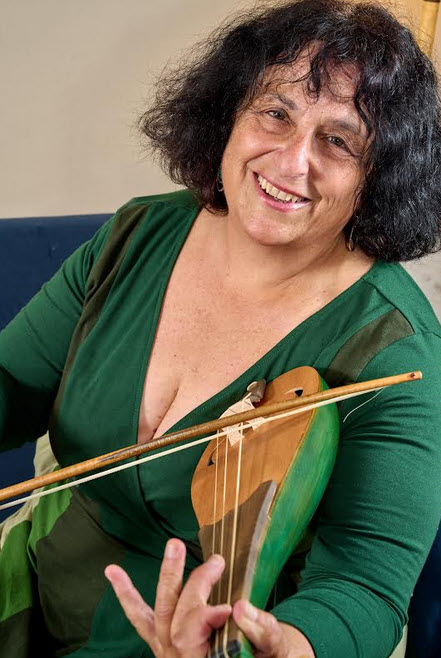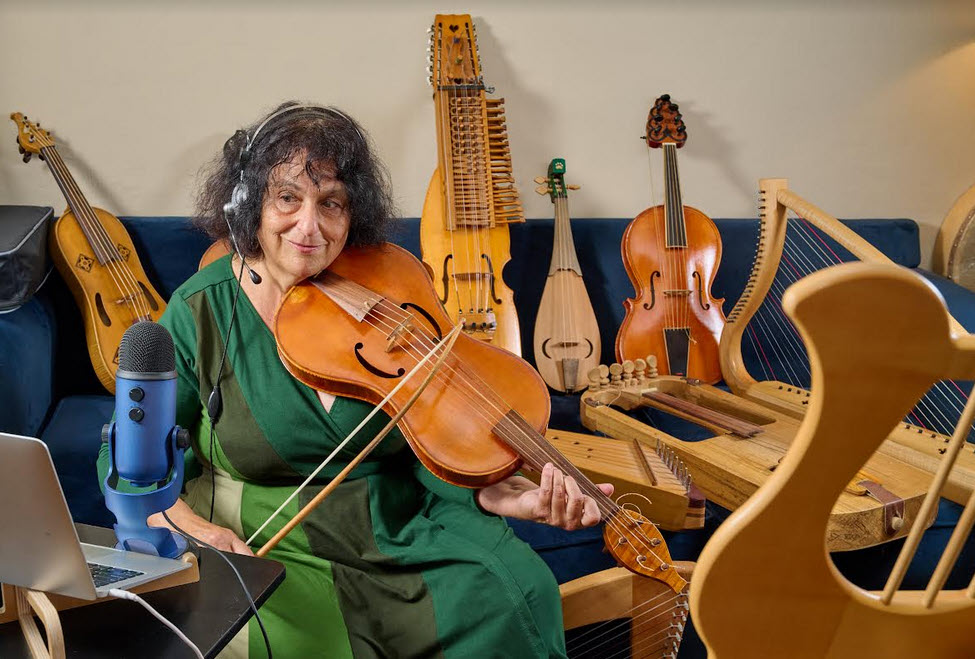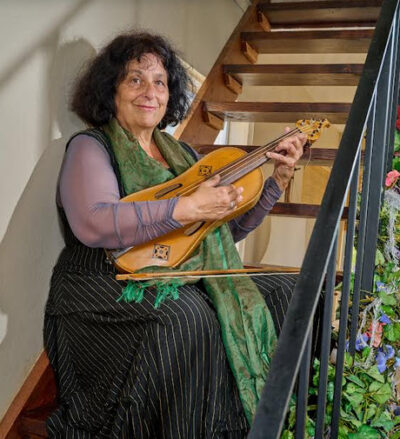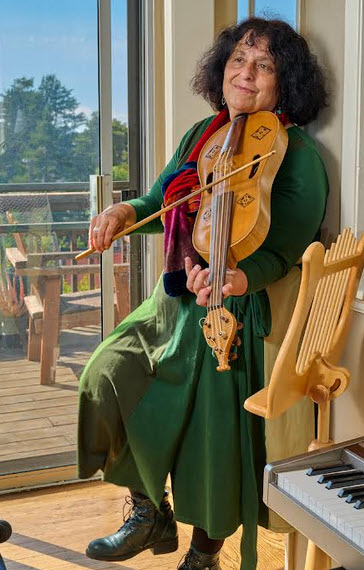An unsung star of early music, Shira Kammen refreshes medieval music and everyone around her
‘Everybody’s playing jumps up a notch.’

“The Berkeley Music Festival is happening this week,” Shira Kammen says on a recent Zoom call from her bungalow in El Cerrito, the Bay Area town she’s lived in since she was three. “Parking is exciting.” The 61-year-old vielle and violin player laughs, as she often does. She seems to find joy in everything.
Raised by a violinist mom and a scientist dad who was a serious amateur singer, Kammen studied music at the University of California at Berkeley. Across her career she has performed and recorded with countless early-music ensembles and coached countless players in workshops around the country. She is particularly renowned for her skill as an improviser, something she first contemplated as a young player when she realized that not every recording of the same piece sounded the same. She gives credit to her mentor, vielle player Margriet Tindemans, for encouraging her to develop her improvisatory skills.
Purposeful creativity lies at the heart of Kammen’s approach to improvisation. “You’re trying to find out what is missing, if anything, and then how to create that. With early medieval music, when you have a bunch of dots in space and no designated rhythm, you look at whatever clues you can and see if you can somehow serve this piece.”
One source for clues is the language being sung. “What is it to accompany Occitan rather than French? Margriet would ask, ‘Can you make a consonant on your instrument? M or P?’ I kind of believe you can. It all goes back to whether you can listen quietly enough and deeply enough.”
The music, she believes, has needs: “What is it that the piece wants? A drone? A cadenza? Does the piece want nothing? How can you make this piece come alive in a way that somehow honors the piece but also recognizes that you are in this time and space, with this instrument in this room?” As one of her composition teachers at Berkeley used to ask, “What do you want to hear now?”
The improviser must also avoid falling into traps, Kammen says. “I start recognizing that I have certain formulas, and then I have to ask myself, am I defaulting to that because I can’t think of anything else? What am I going to do so that it’s not just pretty noodling?” Overdoing it is a constant threat. “You can very quickly busy up a piece so much that you lose the piece.”

It doesn’t take long to realize Kammen is a natural teacher. In 2015, when vielle player Allison Monroe was a doctoral student at Case Western Reserve University, Kammen was invited to coach the school’s Collegium Musicum. Monroe remembers the impact Kammen had on her as they attempted some Italian estampies: “It was hard to get a sense of how this music was exciting. And when Shira came, the whole world opened up. She’s so creative and unafraid to venture off the page. She really encouraged us to just try things.”
‘When Shira came, the whole world opened up. She’s so creative and unafraid to venture off the page.’
David McCormick, executive director of Early Music America, is also a vielle player. He had a similar experience with Kammen when he was at Case Western around 2008. “I’d been in the Collegium for about a year and a half. I was learning a lot about medieval music, but I just hadn’t quite made that connection to the vielle. And then Shira came, and we just sat in a room and had a jam session, the two of us, and I suddenly understood what the vielle was all about.”
Kammen’s revelations about improvising particularly inspired McCormick. “Her wonderful free-spirit approach to the vielle resonated with me as someone who had grown up playing jazz but didn’t realize that I had permission as a medieval player to really go to town.”
Asked how she goes about teaching improvisation, Kammen laughs. “I keep asking myself that! One thing that’s important is having some limitations for yourself. Having some rules. It doesn’t mean that you have to stay with the rules forever. But you have to try them on.”
The limitations can take many forms. “You could say we’re going to play in this mode, and you can play one of these five notes, but you can’t have rhythm. Or you’re going to withhold the final until the end. Or think of a sentence and its phrasing, and play the rhythm of it. I think that reducing choices is really good. You just keep experimenting. And then you can discard it.”
 Terms like “freedom” and “experimentation” come up a lot when she discusses improvising, but she has also scoured the historical literature for guidance. “I’m very fond of [Johannes de] Grocheio. He writes that the vielle is the closest instrument to the human voice and that it can play this kind of piece and that kind of piece. He might even give a couple formulas for postludes. And other theorists tell you certain tunings you can use for the vielle.” And she doesn’t limit herself to theoretical treatises. “There’s a lot of medieval romances that say so and so the troubadour took his harp, and then he sang a song, and then he made the strings do exactly what the voice had done.” She shrugs. “But you still really don’t know what they did.”
Terms like “freedom” and “experimentation” come up a lot when she discusses improvising, but she has also scoured the historical literature for guidance. “I’m very fond of [Johannes de] Grocheio. He writes that the vielle is the closest instrument to the human voice and that it can play this kind of piece and that kind of piece. He might even give a couple formulas for postludes. And other theorists tell you certain tunings you can use for the vielle.” And she doesn’t limit herself to theoretical treatises. “There’s a lot of medieval romances that say so and so the troubadour took his harp, and then he sang a song, and then he made the strings do exactly what the voice had done.” She shrugs. “But you still really don’t know what they did.”
The lack of concrete evidence doesn’t faze her. “Maybe it’s a very naïve California part of me that thinks musicians can’t have been that different. In the end, as a performing musician, you have to serve the moment that you’re in. You have to just commit to something and play it, even if it’s totally ‘wrong,’ something that an academic would disapprove of. ‘Oh, I shouldn’t do that because that’s the trill from the wrong direction.’ Your goal is to consider the scholarly stuff and the music and all the sources, but then when you’re doing it, you have to just forget about all of it.”
Constant learning is another key element. Kammen has wide-ranging experience with traditional music, referring to herself as a “musical tourist.” She has a particular love for Balkan and other Eastern European music, and she loves Turkish music “although it makes my head explode because it’s really hard.” Lately she’s enjoyed playing Sephardic music, finding it similar to the early medieval repertoire “because it’s a blend of cultures and not always traceable.”
California-based multi-instrumentalist Jim Oakden has collaborated with Kammen in traditional genres for decades. They started in the 1990s playing music of Brittany, and have since added Galician, Scandinavian (for which she plays nyckelharpa), and English country dance and contradance music, particularly with their band Roguery. “She’s very good at partitioning,” Oakden says, “which you have to do if you play 10 different genres.” And she takes that very seriously.” Her band Janam illustrates this claim. Their arrangements start with Turkish, Balkan, and Greek music but then morph into Americana. “It’s the most unsalable band I’ve ever been in,” she says with a laugh, “but it’s really fun.”
Fun often seems to outweigh profitability in Kammen’s career decisions. The wide-ranging projects she takes on are done primarily for love of the music and her colleagues. She seems to be as content teaching at an obscure music camp as she is performing with big names like the Boston Camerata or Sequentia.
Among Kammen’s work done more for love than fame are her recordings of traditional Mexican music with Los Cenzontles, a Berkeley-based collective co-founded by guitarist Eugene Rodriguez. “Everything Shira does is so refined but also so free spirited,” Rodriguez says. “It’s always a joy to hear her improvise. She has the ability to create architecture, like if you were doing a solo on a Led Zeppelin song, where it soars in the middle.”
Los Cenzontles features Kammen on their album A la mar, which includes several Mexican styles. Kammen found it quite challenging. “It had rhythms that were so far flung, I could never figure out where the one [beat] was. I kept asking Eugene, ‘Where is it? How do I think about this?’ And he would say, ‘Don’t even ask yourself where it is!’”
Rodriguez appreciates Kammen’s respect for the conventions of Mexican music. “Traditionally the Huasteco music is tuned down a half step,” he says. “Shira doesn’t want to tune her instrument down because it messes with her intonation. But she does it.” For Kammen, it was the obvious choice: “You try to make your own rules of conduct. Do you want to respect those who know those cultures?”
“I need to channel Shira!”
Sometimes she finds herself bringing one tradition into another—within limits. “If you’re doing medieval English music, I wouldn’t try things from North African or Middle Eastern stuff. I would try to have some kind of context or logic. With medieval music, you don’t often go for a bunch of thirds because thirds are usually treated as dissonances, unless you’re in England, which is its own thing.”
No matter the style, Kammen always takes clues from modality. “It’s not that all trad music from everywhere is using the medieval modes, but there are a lot of modes or patterns in various traditions.” Monophony is another common factor. “You’re often dealing with a single line that gets treated in various ways depending on whether it’s a song or dance. Am I trying to enable a dancer to dance vigorously, or is there a poem that I’m accompanying?”
Former student Monroe attributes much of Kammen’s effectiveness to her use of drones. And there’s more to it than picking a particular pitch. “I would think to use some of the same drones in similar situations, but how I would then accompany is often really different from what comes naturally to her.” It’s partly in the bowing, says Monroe: “Her articulation, her attack, is folk influenced compared to other vielle players who tend to play very legato.” When Monroe catches herself playing too smoothly, she thinks “I need to channel Shira!”
Oakden calls Kammen the Drone Queen, pointing out the importance of that technique in the many traditions they’ve explored. “Swedish music, French music, gurdies and bagpipes, Breton music. She’s adapted to all those types of music because she can insert drones. In all the illustrations that you see on the cathedrals showing medieval people, bagpipes and other hurdy gurdy type instruments are prevalent. There’s a lot of droning going on.”
“I don’t ever want using a drone to be a default setting,” Kammen counters, “because there’s a lot of medieval music that doesn’t end where it begins; it’s not in a mode like we think of it. But if you have a tune suggesting a drone kind of thing, it can be an excellent carpet for people to do their song on.” She also likes adding other notes against a drone to give the illusion of polyphony.
‘New sounds to ponder’
Related to her improvisational skills is Kammen’s ability to arrange music. One constant question for her is how much of an arrangement is needed. “With medieval music, we need to trust the material enough to not feel like we have to vary the orchestration all the time.” Then again, she says, an arrangement can help the listener: “You have to engage the audience in such a way that they can listen to something and not think, ‘Oh, God, here’s another verse!’”
 Communicating with the audience is important to Kammen. She was excited about an upcoming concert with the group Calixtone, where there would be supertitles, videos, and a script. “It is a bother—you have to shlep a lot more things to the venue—but the audience is much more engaged, and I think anything we can do to make it less ‘us and them’ is really important.”
Communicating with the audience is important to Kammen. She was excited about an upcoming concert with the group Calixtone, where there would be supertitles, videos, and a script. “It is a bother—you have to shlep a lot more things to the venue—but the audience is much more engaged, and I think anything we can do to make it less ‘us and them’ is really important.”
Another opportunity to present old music in a new way came when the ensemble Alkemie invited her to contribute material to Verdant Medicine, a tribute to Hildegard of Bingen. David McCormick plays vielle in Alkemie. “The word ‘arrangement’ doesn’t begin to describe what she did,” he says. “They’re truly original compositions. I was especially taken by a six-voice work that she crafted just for voices. It was so striking and moving and both modern and old at the same time, which is something I really love about where medieval music is sitting right now. We’re giving audiences new sounds to ponder, and I thought this was a particularly good example of that.”
About that piece for voices, Kammen says, “It has Hildegard motifs, but it’s modern. It doesn’t sound medieval, but it doesn’t sound not medieval, either.”
‘It doesn’t sound medieval, but it doesn’t sound not medieval, either.’
She also contributed what McCormick describes as “the most beautiful, adorable even, piece for three vielles.” He played it with Kammen and fellow Alkemie band member Niccolo Seligman. “It was a really cool moment for Niccolo and me to play with someone that we both consider to be a mentor. It’s pretty rare to have three vielles in a room.”
Not that Kammen always plays in a room. She is known for finding unusual performance venues, including 15 years of commercially run river rafting trips with her band Class V Music. After a day on the river, they would play baroque tunes in the afternoon and folk music around the campfire after dinner.
In 2001 Kammen recorded the CD Music of Waters in the Grand Canyon, taking advantage of the natural acoustics. It was such a moving and satisfying experience that she repeated the trip ten years later; now she hopes to create a series of recordings in western national parks. Another recording series she aspires to, if she can find funding, is a “gigantic DuFay project.” She’s even set some poems from Tolkien’s The Lord of the Rings which she’d like to keep working on, even though she can’t legally release them.
“I’ll play them for my cat,” she says.
And she wants to do more composing. “I do like the quieter part of just messing with music and seeing what can happen.” Her compositional vision is rather dark: “I want to do something that’s about the folly of the upside-down world, called Mundus Inversus. It would be a combination of medieval and new pieces encapsulating the way it feels to be around right now while things appear to be burning.”
Despite that grim view, Kammen has a reputation for actively cherishing her community. The projects she undertook during the pandemic lockdown are good examples. One was Playing with Phantoms, a website she started with Oakden, who explains: “We were thinking of ways that could allow people to keep active in music even if they’re sitting in their living rooms by themselves.” What they came up with was Music Minus One for English country dance. They recorded two melodic instruments and a backup piano on separate tracks, so people purchasing the music could silence one track at a time to get some practice in.
And then there was Noony Tunes. According to Oakden, “One day she went online and said let’s all get together wherever you are at noon, and we’re all going to play this tune together. She had people from 15 different countries joining in every day at noon to play along. It went on for almost a year and a half.” She and Oakden also did a series of online concerts, providing accompaniment for isolated dancers and work for fellow musicians.
Those colleagues have nothing but glowing praise for her. “She just makes everyone around her feel good,” says Oakden, “and everybody’s playing jumps up a notch.” In Monroe’s words, “Her playing is like her personality. It’s extremely warm and welcoming and invites you into a space. I wish I got to play with her all the time.” McCormack echoes that sentiment. “I hope that the universe gives me a few more opportunities with Shira.”
Despite such tributes, Kammen only seems interested in what more she can do for music. For many years she has played medieval harp in hospitals. “It’s been kind of incredible,” she says. “It makes me think a lot about music in the service of things.”
Music and service. No matter what she’s playing, those are Shira Kammen’s watchwords. Service to her students, to her colleagues, and to the music itself. It’s not an easy way to make a living, but like any master improviser, she’s always ready to take on whatever’s next.
Anne E. Johnson is a music journalist based in Brooklyn. After undergraduate training in Greek and Latin at the University of Wisconsin-Madison, she wrote her master’s thesis on medieval music theory at Queens College. She covers classical music for the webzine Classical Voice North America, indie rock for Stereophile, and various musical genres for PS Audio’s Copper Magazine. When she’s not writing, she can be found playing and teaching Irish traditional music at the Irish Arts Center in New York.

